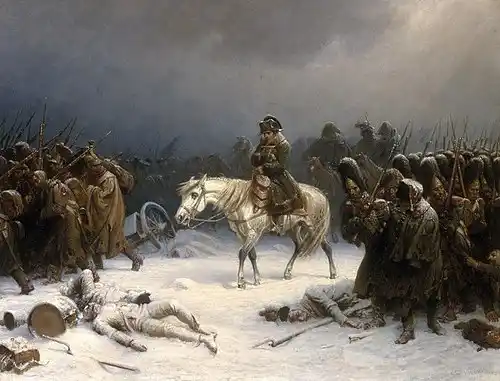
The Napoleonic Wars were a series of conflicts which were fought between 1803 and 1815. The wars were effectively a continuation of the French Revolutionary Wars which had begun in 1792 as countries like Britain and Austria attempted to overthrow the French Revolution of 1789 and the political experiment it augured the arrival of in France. The French Revolutionary Wars had finally come to an end in 1802 with the Peace of Amiens between France and Britain. By then Napoleon Bonaparte had become First Consul of France and in 1804 he was proclaimed as Emperor of the French. The wars were long and bloody and saw Napoleon conquer much of the continent in the 1800s before losing all of it after a disastrous invasion of Russia in 1812. They ended with Napoleon’s defeat, abdication and exile to the island of St Helena. Displacement and migration happened in various parts of Europe at different stages during the conflicts.[1]
Research your ancestors on MyHeritage
Napoleonic wars chronology of eventsNapoleonic wars chronology of events
The french revolutionThe french revolution
The wars which erupted again in 1803 and lasted down to 1815 are termed the Napoleonic Wars to indicate that these new conflicts were driven more by Napoleon’s ambition to be master of Europe rather than being born out of European antipathy to the French Revolution which had fueled the wars of the 1790s.
The French Revolution began in the summer of 1789 as the French Estates General met for the first time in 175 years. They quickly sidelined the king and his government and began revolutionizing France’s politics and society. Eventually in 1792 the monarchy was dispensed with altogether and a new French Republic was declared. These events were perceived as a political abomination in many European capitals and in 1792 an alliance of powers led by Britain and Austria went to war with France in an effort to destroy the Revolution and restore the French monarchy. This was the start of the French Revolutionary Wars, which consisted of two relatively self-contained conflicts, the War of the First Coalition (1792–1797) and the War of the Second Coalition (1798–1802). The Peace of Amiens in 1802 brought the only brief respite from hostility between France and Britain in a period of 23 years.[2]
Not only did France manage to survive these conflicts, but it prospered, conquering much of the Low Countries, the west banks of the River Rhine in western Germany and northern Italy, throughout which regions sister republics were established. However, the Republic did not survive them politically. As the military crisis developed it gave way first to terror in the shape of the Committee for Public Safety and then finally in 1799 to the military dictatorship of Napoleon Bonaparte, a general in the French military who hailed from the island of Corsica and ironically was of Italian heritage. In late 1799 after a coup d’état he established the Consulate as a new form of government with himself as First Consul of France. In December 1804 the pretense of France still being a republic was dropped when Napoleon was crowned as Emperor of the French.[3]
British declares war on FranceBritish declares war on France

Peace did not last for long and in May 1803, after just 14 months of a ceasefire, the British declared war on France again. There would be almost constant fighting for the next twelve years. These conflicts are known as the Napoleonic Wars to distinguish them from the earlier French Revolutionary Wars of the 1790s, as the new conflicts were broadly the result of Napoleon’s ambitions. He was the unifying character who held the clashes together, though British animosity towards France shouldn’t be understated either. The Napoleonic Wars consisted of five individual conflicts. The War of the Third Coalition lasted up to the end of 1805 when Napoleon comprehensively defeated the Austrians yet again, seizing Vienna and defeating a combined Austro-Russian force at the Battle of Austerlitz.[4] The War of the Fourth Coalition followed immediately thereafter in 1806 and was principally fought between France and an alliance of Prussia and Russia in Central and Eastern Europe. Napoleon’s victory over the Prussians at the Battle of Jena-Auerstedt and the capture of Berlin eventually forced King Frederick William III of Prussia into signing the humiliating Treaty of Tilsit in July 1807 which stripped Prussia of much of its territory and reduced it temporarily into being a second-rate power.[5] The War of the Fifth Coalition was a brief affair in the spring and summer of 1809 in which Austria made another effort to get the better of Napoleon, only to suffer another crushing defeat and be stripped of even more of its territory.[6]
The peak of napoleon's empireThe peak of napoleon's empire

In the aftermath of the War of the Fifth Coalition Napoleon’s empire was at its height. He himself ruled France and the Kingdom of Italy, with France’s direct sphere of control extending into the Low Countries, western Germany and even parts of the western Balkans. Furthermore, his family members and allies had been placed on the thrones of Spain and Naples and other countries, as well as vassal states such as the new Duchy of Warsaw having been created in Poland. However, it was at this juncture that Napoleon’s ambitions overran his ability to implement them.
Napoleon's advance into RussiaNapoleon's advance into Russia
In the summer of 1812 he decided to invade the Russian Empire, the last power on continental Europe which he had not comprehensively defeated. The invasion was a mixed affair. A swift advance into Russia led to the capture of Moscow, but thereafter everything went wrong. The Russians abandoned their capital, burning it down before they left and refused to surrender. Napoleon tried to retreat out of Russia, but his forces were decimated on their way back to Poland as the harshest winter of the nineteenth century struck. A new coalition formed against France and in the War of the Sixth Coalition Napoleon was finally defeated.[7] He abdicated in the spring of 1814 and was exiled to become the emperor of the island of Elba off the coast of Italy. After a few months he returned to France, reclaimed power and attempted to re-establish his empire, but after just over three months he was defeated at the decisive Battle of Waterloo in modern-day Belgium. Thereafter he was exiled permanently to the island of St Helena, one of the remotest places in the world lying in the middle of the South Atlantic Ocean. He died there in 1821.[8]
Extent of migration associated with the Napoleonic WarsExtent of migration associated with the Napoleonic Wars
The Napoleonic Wars were the most wide-ranging and destructive conflicts seen in Europe prior to the twentieth century. The scale of the invasions and battles was immense. Where the clashes consisted of armies of a size of twenty or thirty thousand men in the 1790s, by the late 1800s and early 1810s these had expanded exponentially. The invasion of Russia in 1812 involved half a million French soldiers and allies, making it the largest military invasion ever undertaken up to that point. Half a million soldiers fought at the Battle of Leipzig, the defining clash of the War of the Sixth Coalition, in October 1813, and the largest battle ever fought in Europe up to that point.[9] As a result of all this there was a growing displacement of people, migration and flow of political refugees between 1803 and 1815, one which continued after 1815 as many people returned to homes and lands they had fled during the wars of the 1790s, 1800s and 1810s.
Demographic impact of the Napoleonic WarsDemographic impact of the Napoleonic Wars
The demographic impact of all of this is hard to assess owing to a lack of detailed records on the same. Some points can be made though. One region of extreme demographic change, at least in the short-run, was in Moscow and its hinterland. The city had expanded to over quarter of a million inhabitants in the early nineteenth century. It was utterly destroyed by the fires which the retreating Russians lit in the autumn of 1812. Thus, in the short-run the city was devastated, but as with many such disasters, the rebuilding process created such a wave of employment and new wealth creation that by 1840 the city had returned to its pre-invasion levels and expanded exponentially thereafter to 350,000 by mid-century and to 600,000 by 1870.[10]
Elsewhere people moved over and across borders. For instance, when the Duchy of Warsaw was created as a new Polish state in 1807 it led to German migration westwards into what remained of Prussia and Polish migration from Prussian and Russian lands into the territory of the Duchy. One very notable element of this came after the war as Russia’s territory in Poland was formed into the Congress Kingdom of Poland, a part of the Russian Empire, though one with extensive autonomy. This became a haven of Jewish settlement in the nineteenth century, with the Jewish population expanding from 210,000 people here in 1815 to over a million by the 1880s.[11]
See alsoSee also
Explore more about the Napoleonic WarsExplore more about the Napoleonic Wars
- France, Vital Records Index record collection on MyHeritage
- France Newspapers and Periodicals record collection on MyHeritage
- France, Legion of Honour record collection on MyHeritage
- Waterloo Medal Recipients, 1815 record collection on MyHeritage
- New Records on MyHeritage: France, Germany & Sweden at Legacy Family Tree Webinars
- Napoleon Bonaparte Family History & Historical Records record collection on MyHeritage.
- The Lesser Known Story of Napoleon’s American Legacy at the MyHeritage blog
References
- ↑ https://www.worldhistory.org/timeline/Napoleonic_Wars/
- ↑ https://www.worldhistory.org/French_Revolutionary_Wars/
- ↑ https://www.history.com/topics/european-history/napoleon
- ↑ https://www.napoleon.org/en/history-of-the-two-empires/articles/prussia-the-third-coalition-and-the-battle-of-austerlitz/
- ↑ https://www.worldhistory.org/War_of_the_Fourth_Coalition/
- ↑ https://www.worldatlas.com/history/war-of-the-fifth-coalition.html
- ↑ https://www.history.com/news/napoleons-disastrous-invasion-of-russia
- ↑ https://www.historic-uk.com/HistoryUK/HistoryofBritain/Napoleons-Exile-on-St-Helena/
- ↑ https://www.history.com/topics/european-history/battle-of-leipzig
- ↑ Albert J. Schmidt, ‘The Restoration of Moscow after 1812’, in Slavic Review, Vol. 40, No. 1 (Spring, 1981), pp. 37–48.
- ↑ https://yivoencyclopedia.org/article.aspx/poland/poland_from_1795_to_1939

